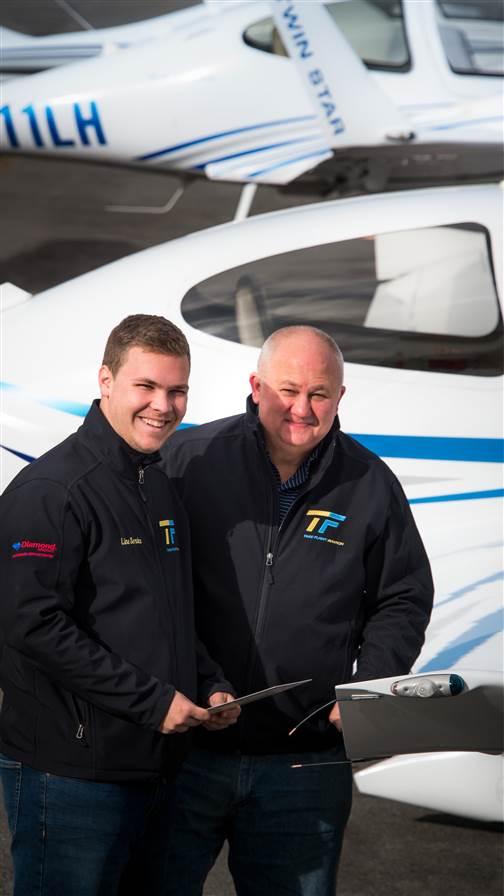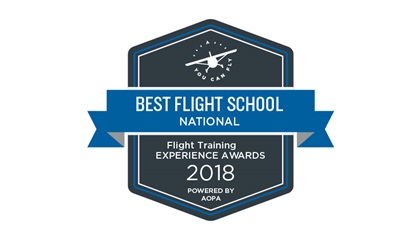All the right moves
Take Flight Aviation proves naysayers wrong

Ryan Mayo accepted the national Best Flight School honor during the Redbird Migration Flight Training Conference held at the AOPA You Can Fly Academy at AOPA headquarters in Frederick, Maryland.
Photography by Donnelly Marks
Mayo does not worry about naysayers. He focuses on making his flight school, Take Flight Aviation, as good as it can be. Every year since its launch in 2010, Mayo has acquired aircraft, revamped syllabi, and created a culture aimed at convincing pilots in the New York City metropolitan area that Take Flight is the place to be.
And it’s working. In 2018, Take Flight went from 200 to 400 clients. Take Flight was named Best National Flight School in the 2018 Flight Training Experience Awards, after being named Best Northeastern Flight School in 2017, and earning the President’s Choice and Outstanding Flight School in 2016.
Diamonds on deck
A fleet of Diamond DA20 and DA40 aircraft sits outside the blue Take Flight hangar at Orange County Airport (MGJ) in Montgomery, New York. The flight school began transitioning to Diamonds in 2015 because Mayo wanted customers to have access to a modern, uniform fleet with up-to-date avionics. He chose Diamond Aircraft because, “for the first time in aviation, I felt I had found someplace where I could buy a product and I had some support behind me,” he said.
The fleet includes a twin-engine DA42NG, five DA40s, and four DA20s. There are also three Piper Warriors and a Tecnam P92 Eaglet Light Sport aircraft.
A Redbird full-motion flight simulator sits in the main classroom. Mayo said he had to “beg, borrow, and steal” to get a loan for it—and people couldn’t believe he didn’t put that money into other aircraft.
“I think this is part of the future of training,” Mayo said. “Every large institution that trains pilots has a sim. Why wouldn’t we have a sim?”
The Redbird gets a workout. The sim is integrated into the flight school’s private, commercial, and instrument syllabi. And it helps keep pilots busy and proficient on days when rain, snow, or fog sweep across the region.
Mayo believes the Redbird sim also played a key role in helping Take Flight to get a contract with the Orange County, New York, school system that funnels high school students on a career and technical education track through a private pilot program. The two-year program includes three and one-half days of ground school studies during the week, and flight instruction that is conducted outside of classroom hours. The school districts pay for up to 40 hours of flight instruction, Mayo said.
Since gaining the contract, Take Flight has helped 30 high school students move on to collegiate aviation programs. The high school program is part of a broader goal to open the aviation community to everyone, he said.
“I find a lot of my competitors train [only] foreign students or college students or local pilots or Light Sport pilots,” Mayo said. “I think you need to train everybody in that market.
“I don’t limit our client base,” he said.
Family beginnings
 Mayo got into aviation for personal as well as professional reasons. Working for his family-owned construction business, he knew general aviation could help win clients if he could fly to bid on out-of-town jobs, and he thought he might get a pilot certificate. He started private pilot training, but hasn’t finished. His father, Corey Mayo, was a typical student pilot—he had logged many hours and had even bought an airplane, but he had never progressed to the checkride.
Mayo got into aviation for personal as well as professional reasons. Working for his family-owned construction business, he knew general aviation could help win clients if he could fly to bid on out-of-town jobs, and he thought he might get a pilot certificate. He started private pilot training, but hasn’t finished. His father, Corey Mayo, was a typical student pilot—he had logged many hours and had even bought an airplane, but he had never progressed to the checkride.
“He’s that 80-percent dropout,” Mayo said of his father, referring to the fact that approximately 80 percent of all student pilots never finish. “He was never able to find somebody to have him see a beginning, a middle, and an end.”
Mayo began researching flight schools and was dismayed to discover an industry that seemed stagnant. “I found almost no customer service, from Florida to New York,” he said. “I found poor management but a lot of passionate aviators.”
He decided he would take his own approach to flight training—one borne of extensive research—and create a better mousetrap.
Take Flight started out as a two-person Part 61 operation in two T-hangars and an office not much bigger than the current location’s sim room.
As the business evolved and Take Flight outgrew its first location in 2013, Mayo hired consultant Chris Graessley. “I had a lot of ideas, but I knew I couldn’t get there,” he said. “I knew the staff I needed to hire wasn’t necessarily flight instructors.” With Graessley’s help, Mayo learned how to track conversions of flight instructors—their success rate, the number of introductory flights they were converting to clients.
Mayo and Graessley also began attacking the problem of clients with “disrupted training”—student pilots who’d gotten to a certain point elsewhere but wanted to finish with Take Flight. They worked on a set of criteria to evaluate these customers to determine where they were in the flight training spectrum and where they needed to be—and to avoid making the students spend additional money to relearn what had already been taught.
With those criteria in place, Mayo and Graessley also created a team teaching concept so that Take Flight students could move from instructor to instructor without creating gaps. Learning to fly with the same flight instructor from start to finish is optimal, but it frequently doesn’t happen. But there’s a basis for that in real life, Mayo said: “Do you have the same teacher from kindergarten to high school?”
By early 2014, the flight school was seeing $275,000 in increased revenues. “The second year I was flat, no growth at all,” Mayo said. But by 2016, revenue growth reappeared, and it hasn’t stopped.
Customer service
At Take Flight, excellent customer service takes different forms. It means consistency in the way clients are treated. “The dispatcher, the flight instructor—everyone provides you the same level of service,” Mayo said.
Excellent customer service also takes the form of transparency about the cost of flight training. Clients are counseled to budget between $12,000 and $15,000 for a private pilot certificate. That includes the cost of the knowledge test, checkride, and books. Mayo said he purposefully quotes on the high side so that clients can plan for worst-case scenarios. Most spend $3,000 to $5,000 less than what they expected, he said.
And excellent customer service means talking to potential pilots about why they want to fly, so that the school can adapt its approach to their needs. At Take Flight, it also means being realistic about the challenges of general aviation.
“If a client wants to fly to their house on the Jersey shore, or visit their kid in a Northeast college, then I’m going to tell [them] you need to get an instrument rating,” Mayo said. “I was told, ‘You can’t do that. You’re going to scare them away.’ I think people would value it if you were honest. If they’re going to commit time and money to do this, doesn’t it make sense to give them a view of what that would look like? I didn’t want to build a pilot who got through the private and felt like I had been disingenuous about what you can do with a private pilot [certificate]. Especially in the part of the country we live in.”
Weather challenges aside, Mayo can think of no better place to build pilots than in Montgomery, located west of the Hudson River and within a half-hour flight of the behemoth Teterboro Airport (TEB) in Teterboro, New Jersey. “This is a great place to train pilots,” he said. “Varying weather conditions, Class B airspace—you can get real-world experience. We have one of the few TRSAs left in the country in Scranton [Pennsylvania]. We have literally everything that general aviation has to offer.”
With a Part 141 certification achieved, Take Flight continues to grow. Mayo has been collecting data to quantify the flight school’s success. “As we look at trends, and as we make changes, we see changes in the data for the better,” he said. “You don’t have to agree with me but you have to acknowledge that what I’m doing is working.”
The 38-year-old Mayo is not yet a certificated pilot, and he acknowledges the irony. “I got so busy so fast with this company,” he said. “Every time I flew it was taking [an aircraft or an instructor] away from the customers.”
Mayo is content to focus on the flight school. And he believes his nonpilot status is an advantage. It puts him on the same level as many of his clients. “One of the great advantages I see is that clients will say things to me that they wouldn’t say to a pilot because they don’t want the pilot to be upset with them,” he said. He’s happy to get that feedback, positive or negative—so long as Take Flight continues to succeed.

 Do’s and don’ts
Do’s and don’ts

